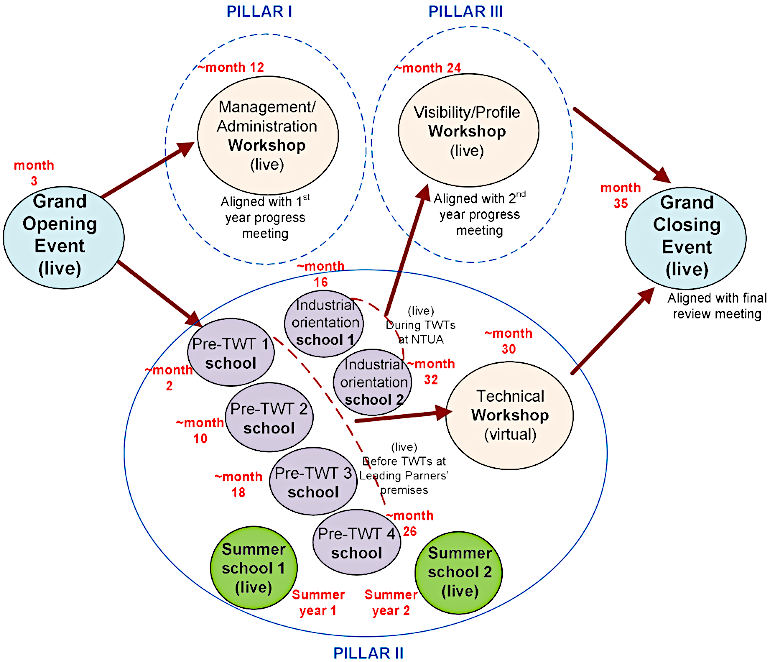
TWEET-IE project aims to upgrade the Wind Tunnel (WT) testing activities at National Technical University of Athens (NTUA). The NTUA WT will be rendered on par with other world class facilities for hosting a variety of research applications in the field of external aerodynamics, primarily focusing on clean-tech, energy and transport applications. It includes knowledge transfer and networking activities with 4 leading European universities: Technische Universitaet Muenchen (TUM), Karlsruher Institut fuer Technologie (KIT), Politecnico Di Milano (POLIMI) and Technische Universiteit Delft (TU Delft), which have all been successfully operating their own large WTs for decades and have remarkable scientific and research track records.
Project Nr: 101079125
Call Topic: HORIZON-WIDERA-2021-ACCESS-03-01
Duration: 36 months (1 November 2022 - 31 October 2025)

TWEET-IE is conceptually based on three distinct pillars i) enhancing administration and management capacity, ii) upgrading technical competence and iii) improving visibility and profile of the facility. Renewable energy sources, clean-tech and energy efficiency in the urban environment will be the cornerstones for accomplishing EU’s energy and climate ambition to render Europe the first energy neutral continent by 2050 and WT experiments are indispensible for analyzing issues related to wind energy and environmental flows. This is one reason that upgrading the in-house WT has been prioritized as a research goal of paramount importance for both the School of Mechanical Engineering, NTUA and the labs involved in the WT management and operations. TWEET-IE’s primary goals will be achieved through systematic work and seamless communication between project working groups, comprising key personnel from all partners, and a series of networking, training and research activities and events, in which all leading members of the consortium play an equally important role. TWEET-IE’s strategic research goal is to address the challenge of measurement conformity among different WT. Four identical state-of-the-art test campaigns will be repeated in different tunnels, serving the strategic goal, the improvement of NTUA’s technical capacity and also stimulating research innovation and excellence per se.
Keywords:
- Architecture, smart buildings, smart cities, urban engineering
- Fluid mechanics, hydraulic-, turbo-, and piston engines
- Renewable energy sources
- Energy efficiency
Partners Activities:
National Technical University of Athens (NTUA)
The goal of the present project is to re-invent, mobilize and promote the NTUA WT for EU level research through shared experience with top-class Leading Partners. NTUA WT will host four different state-of-the-art test campaigns that will be repeated in different top-class Wind Tunnels. The process of these Twin Wind Tunnels Tests and the analysis of their results will be the NTUA's basic activity, which is expected to support the following strategic goals:
Stimulate institutional reforms with regard to WT management at NTUA.
Knowledge transfer and exchange of best practices between Leading Partners and NTUA.
Achieve R&I excellence of WT studies at the NTUA facility and improve reputation and research profile of NTUA WT facility and supporting staff.
Establish strategic networking activities between NTUA and top-class partners.
Improve creativity and establish innovation activities around NTUA WT facility.
Technical University of Munich (TUM)
The Wind Energy Institute at TUM (TUM-WEI) will contribute to the project by providing its expertise on the design and operation of scaled wind turbines for wind tunnel testing. TUM-WEI has developed a family of wind turbine models, which includes at present three different types: the G2, G1 and G06, respectively with rotor diameters of 2, 1 and 0.6 meters. The turbines are used for modeling wind turbines clusters, studying wake interactions, and testing turbine and farm-level control strategies. The scaled models are miniaturized wind turbines equipped with load sensors, and -exactly as full-scale machines- they are governed by closed-loop pitch, torque and yaw controllers. Clusters of turbines can be collectively operated by a farm-level supercontroller.
TUM-WEI will provide training on the design, manufacturing, assembly, calibration, and operation of the turbines, including the analysis and post-processing of measured data. Some G1 turbines will travel to the NTUA, TU-Delft and POLIMI wind tunnels, where they will be tested in a variety of operating conditions and with a range of flow measurement devices. Prior to these experimental campaigns, partners will be trained on the correct use of the models in the labs of TUM-WEI and in the Wind Tunnel C facility, which is operated by the Chair of Aerodynamics and Fluid Mechanics at TUM.
Karlsruhe Institute of Technology (KIT)
The Laboratory of Building and Environmental Aerodynamics (LBEA) at KIT will contribute to the project by providing expertise on flow and pollutant dispersion at building and street canyon scale. Particular focus is on the effects of urban vegetation, e.g. street trees and facade / roof greening, on natural ventilation of outdoor and indoor spaces and air quality. LBEA has developed a vegetation modelling concept for the study of the effects of vegetation on flow, turbulence and scalar transport in the built and natural environment in reduced-scale wind tunnel experiments.
The Laboratory of Building and Environmental Aerodynamics will provide training on modelling vegetation including its design and employment in wind tunnel experiments. The training encompasses laser optical flow and concentration measurement techniques in the context of urban outdoor and building interior flows in the presence of vegetation, their analysis and evaluation. The vegetation modelling concept will be employed at building and street canyon setups in wind tunnel facilities at NTUA, TU Delft, and KIT.
Technical University of Delft (TU Delft)
In the TWEET-IE project, TU Delft will contribute to the Twin-Test on the Scale Effects in Urban Flow Wind Tunnel Studies. Robotic volumetric PIV measurements will be performed for the street canyon configuration to investigate the flow topology at Reynolds numbers between 7,000 and 50,000. The goal of the investigation is to address the Reynolds numbers effects for the street canyon configuration at Reynolds numbers in proximity to the critical value of 10,000. Additionally, TU Delft will lead the work package 2 on Widening of Administration and Management Capabilities of the NTUA wind tunnel
Politecnico di Milano (POLIΜΙ)
In the TWEET-IE project, the Wind Energy Lab. of the Department of Aerospace Science and Technology of the Politecnico di Milano (POLI-Wind) will contribute to the Twin-Test by studying microdevices to improve the performance of airfoil sections. Several devices will be investigated for enhancing performance but also for mitigating loads. Steady-state measurements for all the devices will be performed (parametric study for various fixed positions of the device and steady inflow conditions at various angles of attack) to characterize the performance of the airfoil sections equipped with such devices. The wing model (owned by NTUA) will be equipped with high frequency pressure sensors for unsteady pressure recordings and the twin tests will be conducted in the high speed (small) section of NTUA WT and in the high speed (aeronautical test section) of POLIMI WT. Moreover, POLI-Wind Lab. will also conduct the TUM-WEI G1 turbines experiment in the Boundary Layer test section of the POLIMI Wind Tunnel.






